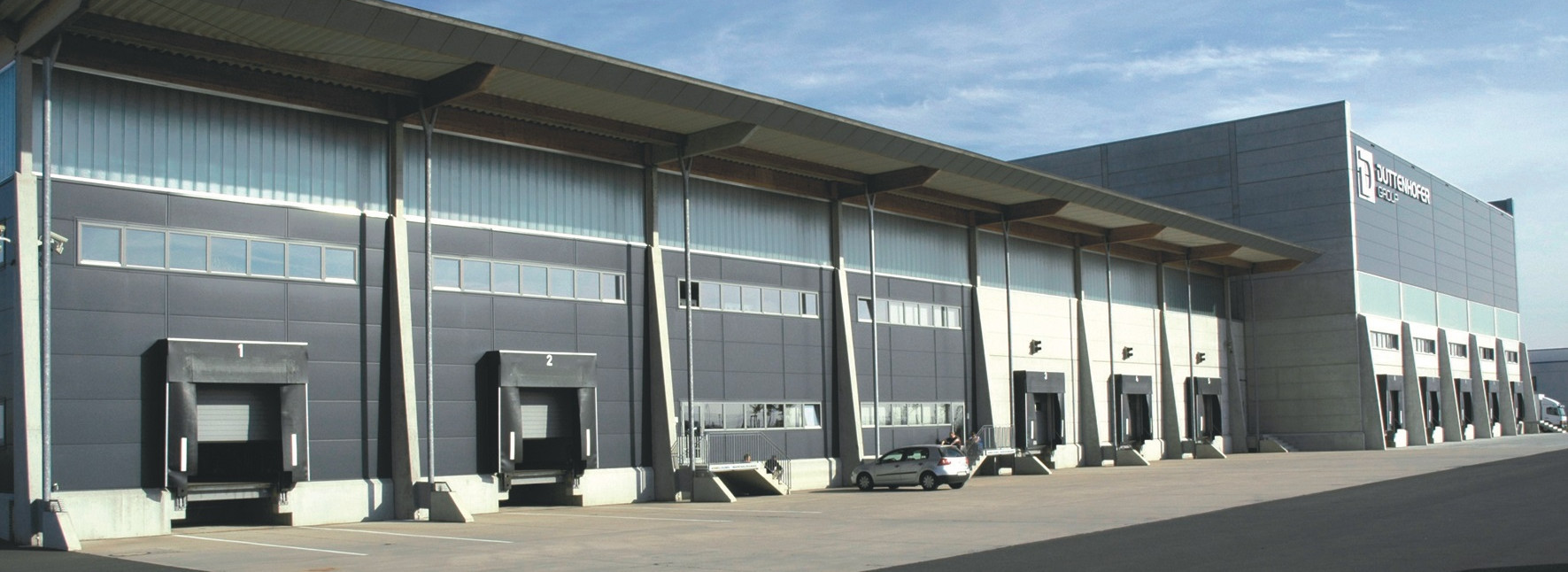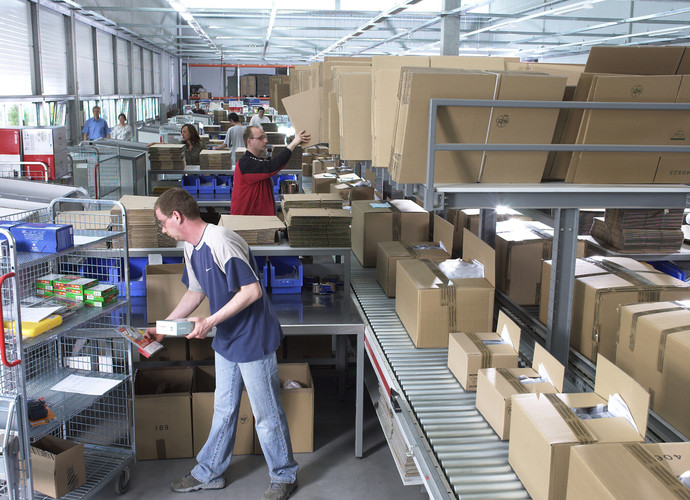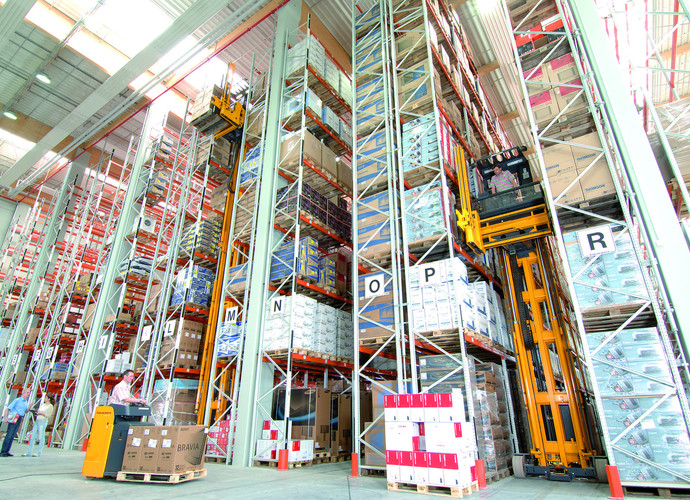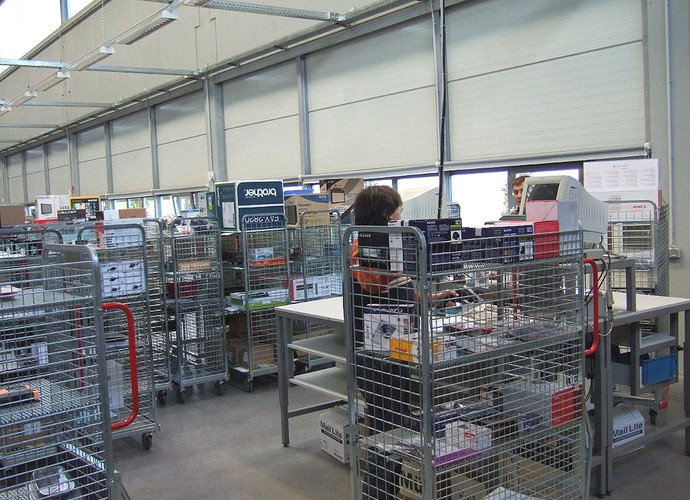The Duttenhofer Group comprises six mail order companies active in the distribution, wholesale and retail sectors. Each of these six companies possesses its own Internet shop. Consumers, for example, may be familiar with Duttenhofer through its technikdirekt.de site. "From single-item orders for private individuals through to fully laden pallets for distributors – our online shops receive a huge variety of orders every day," explains Peter Roßhirt, head of Corporate EDP at Duttenhofer. "We adopt the usual e-commerce approach and guarantee our customers 24-hour delivery. This is only possible with fully functional warehouse logistics. That is why we decided to introduce the LFS warehouse management system at our logistics centre in Dettelbach."
Before the deployment of the LFS solution, Duttenhofer used paper-based documents to manage over 20,000 items for its six mail order companies in its 10.000 m² warehouse. All goods movements were performed manually on the basis of printed picking lists – a time-consuming process that meant that the task of checking the correct assignment of warehouse locations was extremely labour-intensive. Since the deployment of LFS, all material and information flows in the Duttenhofer logistics centre are controlled centrally and ensure optimized routing. "LFS supports both Group-wide and multi-client operations. As a result, we were able to meet all Duttenhofer's requirements in the best way possible," explains Marco Ehrhardt, Managing Partner of EPG. "Thanks to the warehouse management system, all the Group's orders can be processed on time and without error. Nowadays, everything is ready for collection at precisely the right time and the shipment of outbound goods within just a few hours is guaranteed."
Optimized storage in four warehouse areas
The central warehouse is subdivided into four areas. The shelving rack area with 44,000 warehouse locations and 13 aisles is used as a simple order picking store. This is where frequently ordered items such as cameras, photo accessories or memory cards are kept. Two further areas house a total of 10,000 pallet spaces. Both dedicated and mixed pallets are stored in a block and high rack system. These areas are used both as an order picking store and for long-term stocks. The fourth area is used to store returned goods and less frequently ordered items. "We were able to take the designations of the warehouse areas over into LFS without difficulty," explains Peter Roßhirt. "That was naturally a great advantage because we didn't have to get used to a completely new set of names."
Two-stage picking
To combine the items from the four warehouse areas quickly and reliably to form orders, Duttenhofer uses a two-stage picking system consisting of so-called pallet and piece-picking. In the first stage, known as pallet-picking, various items for a number of different orders are taken from the pallet store, for example, and stored temporarily on an empty pallet at a central location. In the second, or piece-picking, stage, the items in the intermediate storage location are subdivided and assigned to the individual orders. "If, for example, a customer orders a new printer and a print cartridge or a camera and a memory card, then this type of two-part order can now be assembled faster and more reliably than in the past thanks to the use of LFS," explains Markus Linkenbach, the responsible Project Manager at EPG. "LFS assigns the items a precise storage location for intermediate storage. In contrast to the paper-based picking of the past, warehouse staff are now guided directly to the relevant item – with the result that processing times and error levels are greatly reduced." After picking has been completed under LFS control, the packaged goods enter a semiautomatic packing line and are forwarded for dispatch. Since the introduction of LFS, the pickers have been able to achieve up to 1,200 warehouse admissions, 2,000 stock transfers and 12,000 withdrawals per day.
MDEs support warehouse logistics
The supplied solution was accompanied by 50 EPG MDEs. Withdrawals from stock are confirmed on the MDE and any shortfalls are entered directly and transferred to the warehouse management system. This means that it is possible to track current stock levels and order statuses at all times. Six stacker terminals have been deployed to complement the warehouse's new hardware. These are now used to optimize the routing of Duttenhofer's stackers as they are guided through the aisles of the high-rack storage. In its shelving rack system, Duttenhofer additionally uses approximately 300 route-optimized, guided transport trolleys for multi-order picking. To acquire the expertise necessary to use the new MDEs, six employees from the warehouse control centre attended courses at EPG's in-house training centre in Boppard. These users then passed on their newly acquired knowledge to the remaining warehouse personnel. "At EPG, we have been successfully pursuing this train-the-trainer concept for years," explains Marco Ehrhardt. "Our aim is to equip our customers' staff with the necessary expertise quickly and efficiently so that they can be largely self-reliant in performing their own warehouse management activities in the future."
Convincing results
"When we were looking for a standard software application, EPG offered us the best solution and associated consulting services," summarizes EDP Manager Roßhirt. "LFS is an end-to-end system that controls all stock movements from goods reception through material flows and on to dispatch. These capabilities greatly impressed us." Since the changeover, Duttenhofer has benefitted from higher throughput rates without any change to staffing levels, faster warehouse processes and precise, transparent stock management. In addition, employees and stackers alike are now guided along optimized routes through the warehouse. All transport operations are continuously recorded by the system. "Furthermore, stocktaking operations are now significantly easier with LFS," continues Peter Roßhirt. "It is even possible to perform inventory sampling. With the wide range of items we stock, this is an enormous advantage to us." During the LFS start-up phase, Duttenhofer was able to deliver approximately two thirds of its goods. The changeover to productive operation was accomplished without problems despite the use of the new technology. Peter Roßhirt sums things up as follows: "The support provided by Ehrhardt + Partner was very good both before and after the changeover – all the deadlines were met. And even now, there's always someone available immediately if we want to make small programming changes, for example."





